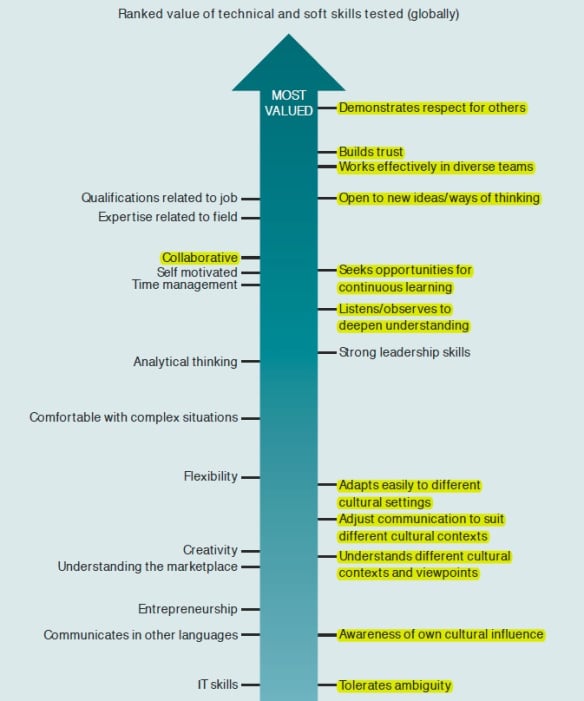Why U.S. Employers Do So Little
Many of the facts below have been confirmed by the 2007 WBI-Zogby Survey.
Bullying is Legal
Most workplace harassment and mistreatment (80%) is completely legal. Remarkably, a hostile work environment is actionable (illegal) only in very few situations.
America’s individualistic society feeds aggression and competition in the workplace. These traits block an empathic concern for the well-being of others, make bullying look tame when compared to other forms of physical violence, and justify inequality of status across ranks within organizations — dubbing a few as winners and the rest losers. Bullying is not only tolerated in business, it is often seen as necessary. Lawmakers are reluctant to pass laws that reign in unfettered workplace violence resulting in psychological injury.
Poor Leadership, Inept Managers
The majority of bullies (72%) are bosses…
- Bullies derive most of their support from…HR. It’s a club, a clique, that circles the wagons in defense when one of their own is accused.
- Some executives command bullies to target particular employees. Bullies are simply good soldiers following orders in a blind fashion.
- Supervisory training is nearly nonexistent. No budget. No time. Few good skills taught. OJT transmits bad habits.
- Executives blame the problem on a “few bad apples,” deflecting blame for systemic causes and denying responsibility for systemic cures.
Employers Don’t Know How to Stop Bullies
Everyone walks on eggshells and is afraid to confront “the golden” bully, the boss’s favorite. HR misapplies the tools of traditional conflict resolution, for example, mediation. Wrong solution for the actual problem. The workplace culture holds no one accountable. Confronting bullies is unthinkable. Executives and senior managers have been badgered by the bully, too. They are afraid of an emotional confrontation. They loathe conflict and remain paralyzed. By not acting, they tacitly endorse the bully. They fear lawsuits brought by the bully if they dare investigate or punish the bully. There is rarely a basis for such suits. The fear is irrational.
Bullying Is Underreported
- Forty percent (40%) of targets never tell their employers…
- Bullying is erroneously branded as “conflict” or a mere “difference in personality styles.”
- Both are true, but bullying is also a form of violence. Simple labels minimize its impact on both people and the organization.
- Historically, complaints lead to retaliation (revengeful hurting) or reprisal (taking away of rights or status).
Knowing this, targets are reluctant to use internal employer processes.
From: Workplace Bullying Institute: www.workplacebullying.org
Here is a very short video (3 minutes or so) by the firm Ernst & Young (http://www.ey.com/US/en/Home) on the importance of Diversity and Inclusion for their business.
One does not need to be a global giant like Ernst & Young to understand the benefits of diversity to business success in competitive markets.
Here is the link to the video. Hope you enjoy it!
Here are some main points in the video:
- Diversity and inclusion are two different things. Diversity is the mix of people. Inclusion is how you maximize that diversity on each team and in the work environment.
- Failure occurs when you have diversity but not inclusiveness, when people don’t feel appreciated for their differences, and the value they bring to the team. There is POWER in diverse teams: diverse people bring different view points to problems, thus leading to creative solutions.
ARE YOU AN INCLUSIVE LEADER?
- Inclusive leaders value team members’ differences.
- Inclusive leaders actively seek out different perspectives.
- Inclusive leaders understand that diversity matters to our firm, and to our clients, and strengthens our global business.
When we bring together our unique backgrounds, perspectives and experiences and abilities together, we achieve so much more!
Work: The value of intercultural skills in the workplace
—A survey conducted by the British Council, Booz Allen Hamilton and Ipsos Public Affairs, of HR managers at 367 large employers in nine countries: Brazil, China, India, Indonesia, Jordan, South Africa, the United Arab Emirates (UAE), the United Kingdom (UK), and the United States (US)
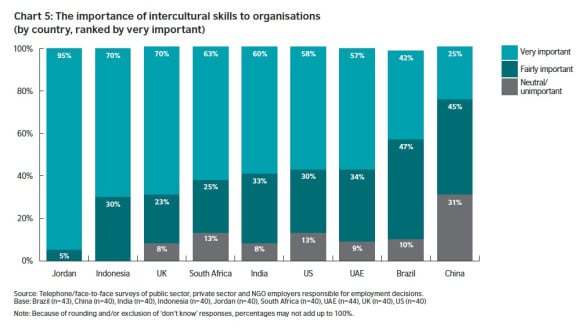 Culture at
Culture at
The Report’s Conclusions
“Our ability to engage successfully with other countries, organisations and people will depend to a large extent on whether we possess the necessary intercultural and foreign language skills to make fruitful connections, whether in trade and investment, charity/NGO programmes or as government and international organisations. This is fundamentally changing the way in which employers value and seek to develop intercultural skills in the workplace.”
“More and more business leaders are identifying real business value in employing staff with intercultural skills. These skills are vital, not just in smoothing international business transactions, but also in developing long term relationships with customers and suppliers. Increasingly they also play a key role within the workplace, enhancing team working, fostering creativity, improving communication and reducing conflict. All this translates into greater efficiency, stronger brand identity, enhanced reputation and ultimately impact on the bottom line.”
“Employers believe that intercultural skills are integral to the workplace.”
“A common challenge shared by employers around the world is finding employees with adequate intercultural skills. Given that the operating environments of all organisations is increasingly global, it comes as no surprise that employers need employees who can understand and adapt to different cultural contexts.”
What is the international reality in the workplace?
The research shows that employees in most large companies surveyed engage in extensive interaction across international borders.
More than two thirds of employers report that their employees engage frequently with colleagues outside of their country, and over half say that their employees engage frequently with partners and clients outside of their country.

THE BUSINESS VALUE OF INTERCULTURAL SKILLS
Intercultural skills provide business value and help mitigate risk.The research shows that HR managers associate intercultural skills with significant business benefits. Overall, the organisations surveyed are most interested in intercultural skills for the benefits they bring—benefits that carry significant monetary value to employers:
- Keeping teams running efficiently
- Good for reputation
- Bringing in new clients
- Building trust with clients
- Communicating with overseas partners
- Able to work with diverse colleagues
- Increased productivity
- Increased sales
Employers also see significant risk to their organisations when employees lack intercultural skills. Top risks that organisations surveyed are concerned about are:
- Miscommunication and conflict within teams
- Global reputational damage
- Los of clients
- Cultural insensitivity to clients/partners overseas
- Project mistakes
How do the organisations surveyed define “intercultural skills”?
The graphic below shows the words employers used, with size of the block equating to frequency of use.
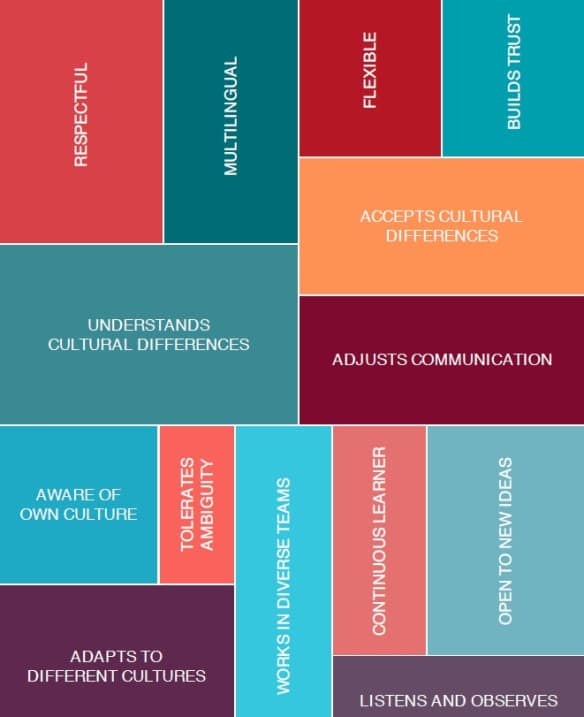
The terms employers use to define intercultural skills
Source: Telephone/face-to-face surveys of public sector, private sector and NGO employers responsible for employment decisions. Base: Ipsos Public Affairs, 2012: Global (n=367).
In particular, employers highlight the following as important intercultural skills that they look for in job candidates:
- the ability to understand different cultural contexts and viewpoints
- demonstrating respect for others
- accepting different cultural contexts and viewpoints
- openness to new ideas and ways of thinking
- knowledge of a foreign language.
How employers rank different skills in terms of importance
Graphic © the original report, with yellow highlights added by Cultural Detective.
How does the research indicate these skills are developed?
Most employers report encouraging their staff to develop intercultural skills through in-house training, meetings and events. However, employers also say that educational institutions could do more to equip students with intercultural skills.
The findings suggest that policy makers and education providers could do more to contribute to the development of a workforce with the necessary intercultural skills through interventions, such as prioritising:
- teaching communication skills
- offering foreign language classes
- availability of opportunities for students to gain international experience
- development of international research partnerships.
This research suggests that there is significant opportunity for employers, policy makers and education providers to work together to strengthen the development of intercultural skills to meet the needs of an increasingly global workforce.
Our October 2012 Lunch and Learn seminar on Mental Health in the Workplace, has attracted a widespread audience, as well as a multitude of comments and debates on what employers can and cannot do when dealing with an employee who has a mental health disability. The general opinion seems to be that if an employee with a mental health issues has problems in the workplace, the best thing to do is “pick on his/her work performance” and not on his/her “issue”. However, ADA considers mental illness a disability, just like any other physical disability, which can affect a worker’s performance. Disability specialist, Marc Brenman looks at a seminal Supreme Court case which favored the dismissed employee, and concluded: “Conduct resulting from the disability…is part of the disability and not a separate basis for termination.”
With the new ADAA , employers will be forced to place less emphasis on determining whether an employee is truly disabled and more emphasis on how it can accommodate the employee’s needs and concerns. The landscape of disability discrimination law has been drastically altered and employers will need to adapt or face additional time-consuming and expensive litigation.
Please contact Marc Brenman directly with any questions.
Guidance about the Decision in Gambini v. Total Renal Care:
Emotional Illness in the Workplace
by Marc Brenman
Social Justice Consultancy
240-676-2436
Copyright 2012
The Ninth Circuit Court of Appeals, in Gambini v. Total Renal Care, Inc., 486 F.3d 1087 (2007), has found that an employer may not be able to terminate the employment of an employee for misconduct, if the misconduct is related to the employee’s disability. The following information is to assist employers and employees in understanding this complicated and controversial decision. This information does not substitute for the advice of an attorney. If you have further questions, or have a particular workplace situation that is of concern, you are urged to contact an attorney.
Case Facts
Gambini was diagnosed with bipolar disorder. She informed her employer of the disability and that she was seeking treatment. She further informed her employer that she was struggling with medication issues, and told her co-workers that these issues may influence her moods. As Gambini continued to have medical issues, her supervisors discussed her attitude and job performance. They decided to issue her a written performance improvement plan. They called her to a meeting without telling her the reason. The first sentence of the performance improvement plan stated, “[Gambini’s] attitude and general disposition are no longer acceptable…” Gambini began to cry, threw the plan across the desk, swore at her supervisor, and slammed the door. Back at her cubicle, Gambini kicked and threw things. The next day, Gambini checked into a hospital. The employer approved her request for Family and Medical Leave, and began an investigation into her behavior at the meeting. The employer decided to terminate Gambini due to her behavior at the meeting. Gambini sent a letter asking her employer to reconsider the termination because her behavior was due to her bipolar disorder. The employer refused, and Gambini sued under a theory of disability discrimination.
The trial court jury returned a verdict in favor of the employer. Gambini appealed the decision, stating that the trial court erred when it failed to give the following instruction to the jury: “Conduct resulting from a disability is part of the disability and not a separate basis for termination.” The appeals court decided, “Where the employee demonstrates a causal link between the disability-produced conduct and the termination, a jury must be instructed that it may find that the employee was terminated on the impermissible basis of her disability.” The court cited Riehl v. Foodmaker, Inc., 152 Wn.2d 138, (Wash. 2004) in which the Washington State Supreme Court stated, “Conduct resulting from the disability…is part of the disability and not a separate basis for termination.” The court went on to say that this decision does not provide employees with absolute protection from adverse employment actions. The employee must still be qualified to perform the essential functions of the job with or without accommodation, and the employer can raise undue burden and direct threat defenses.
Other Decisions
Most other courts have held that an employer does not need to tolerate misconduct by an employee in the workplace, even if that misconduct is caused by the employee’s disability. In Raytheon Co. v. Hernandez, 540 U.S. 44 (2003), the U.S. Supreme Court determined that a company’s policy against rehiring persons who previously violated a work rule, even when the violation occurred due to a disability, was a legitimate, nondiscriminatory reason for refusing to rehire an individual. Other courts have found that employers do not need to waive or rescind discipline if the employer finds out after the fact that the employee has a disability and the disability may have caused the behavior. In addition, courts have held that an employee cannot avoid discipline for misconduct by requesting a reasonable accommodation during the discipline meeting (although once the reasonable accommodation request is made, the employer must engage in an interactive process with the employee). Also, courts have found that an employer does not need to rehire a legitimately terminated employee who requests a reasonable accommodation after the termination. A Ninth Circuit case, Sena v. Weyerhaeuser, 1999 U.S. App. LEXIS 499 (9th Cir. 1999), stated that the ADA does not immunize employees from terminations based on workplace misconduct.
The EEOC has taken the position that employers can hold all employees, even those with disabilities, to the same work-related conduct and performance standards. See 56 Fed. Reg. 35, 733 (1990).
On the other hand, there are cases that support the Gambini decision. In Humphrey v. Memorial Hospitals Association, 239 F. 3d 1128 (9th Cir. 2001), and Dark v. Curry County, 2006 U.S. App. LEXIS 16838 (9th Cir. 2006), the courts stated that with few exceptions (like alcohol and drug violations), conduct resulting from a disability should be considered to be part of the disability, and not a separate basis for termination. Recent guidance from the EEOC has cautioned that if the misconduct resulted from a disability, the employer must be able to demonstrate that the conduct rule is job related and consistent with business necessity. (An example of this would be that an employer is prohibited from terminating an employee who attempted suicide due to depression. On the other hand, an employer can discipline an employee who violates safety rules at a construction site, even if the violation is due to a disability.)
Analysis
On the one hand, the Gambini decision can be seen as an odd ruling by one Court in one Circuit. However, employers should be aware that decisions of this nature could be a trend in the Ninth Circuit and in Washington. Employers should take care to exercise caution when making disciplinary decisions regarding employees whose conduct may be due to disability. If the misconduct resulted from a disability, the employer must be able to demonstrate that the conduct rule is job related and consistent with business necessity.
Some legal professionals, particularly plaintiffs’ attorneys, do not believe that the Gambini decision is dramatic or controversial. They see it as an extension of previous court rulings, and believe that employers are required to tolerate and accommodate unusual and disruptive conduct if the conduct is caused by a disability.
Guidelines for Employers
– Remember that unlike other areas of discrimination law, which require the same treatment for everyone, disability discrimination law does provide more protection for individuals with disabilities, and requires specific actions on the part of employers.
– An employee must be able to perform the essential functions of the position with or without accommodation.
– Have clear, written rules of conduct and a step disciplinary process. Make sure that these rules are job related and consistent with business necessity.
– Make sure to apply these conduct rules consistently to all employees; avoid inconsistent application of the rules and avoid applying them only to certain employees or certain classes of employees.
– Have written detailed job descriptions that incorporate good conduct as part of the job requirements. For example, if it is relevant to the particular job, you may include in the job description: regular attendance, the ability to maintain a calm demeanor in a stressful environment, the ability to interact with co-workers in a variety of situations, the ability to clearly communicate verbally and in writing, and the ability to provide calm and polite customer service.
– When an employee requests reasonable accommodation, enter into the interactive process and agree on a reasonable accommodation that will to assist the employee to abide by conduct rules. An example would be working out a schedule change so that the employee does not violate attendance rules.
– If a conduct rule is violated and the employee argues that a disability caused the conduct, consider halting the disciplinary process to determine if a reasonable accommodation is necessary. If a reasonable accommodation is in place, before you impose discipline determine if there is more you can do to reasonably accommodate the employee so violations do not occur.
– Rules regarding the use of drugs and alcohol can be enforced.
– Think about how closely your fact situation is to the facts in Gambini. Were you aware of the disability? Is the employee seeking treatment for the disability? Is your employee attempting to adjust medication? Does the employee have a disability that manifests itself through poor behavior? How serious was the behavior, i.e. was there verbal behavior, physical behavior, or physical contact? Does your discipline cite attitude and demeanor as a reason for discipline? The closer your facts are to the facts are in the Gambini case, the more careful you should be about imposing discipline.
– Employers have the ability to argue business necessity, undue hardship, and direct threat defenses.
“David Epstein, Division Head of Novartis Pharmaceuticals, spoke with DiversityInc CEO Luke Visconti aartis corporate headquarters in Basel, Switzerland, about how diversity impacts innovation, R&D and marketing. Novartis Pharmaceuticals Corporation is No. 13 on the DiversityInc Top 50.”
Here are some excerpts from the interview, as it appeared in DiversityInc.:
VISCONTI: Can you connect the company’s focus on diversity and inclusion, cultural awareness and cultural competency with your philosophy on research and development?
EPSTEIN: There are a couple of connections. One is we can recruit people, the best people, from anywhere in the world, which is a major advantage. And when you start to recruit these people, they bring in even more people from those regions or those backgrounds.
Working with diverse cultures and backgrounds, you’re also more likely to design your clinical trials in a way that looks for subgroups or different patient characteristics
It’s largely about talent. It’s about getting the very best people in the door and then making the investment to get them to work together in a high-performing team. That means training your leaders to be inclusive—and we do have inclusive leadership training. We just rolled out a program called Leaders as Coaches. It teaches people specific coaching skills as leaders—for example, how to have a conversation with your team members so challenges and options can be addressed openly and in a reflective manner. We also do high-performing team training where the leader and their direct team work together on a multitude of things.
When you first explain to people that we are going to do this, you get the classic reaction: “I have to take two or three days out of my schedule to do this? I have to think differently?” After they’ve been through it, something interesting happens: They say, “This has made me a better leader and it’s had an immediate impact on how we all work together and what we can achieve.
Our strategy is to win in primary care, specialty care and oncology. We want to become the best pharmaceutical company by 2016. There are four major pillars: growth, innovation, productivity and people. The people pillar is very clearly spelled out as becoming more diverse and inclusive, to invest heavily in high-performing team workshops and education so that we can bring out the best in people. We’re very explicit about it.
That is a very broad statement to make. The diversity he is speaking of is a diversity of thought and educational experience. Most Americans when they think of diversity they first think race and then the thought is gender. I have have always told my technology clients that diversity comes in different forms and the true diversity they should look at is the diversity of educational backgrounds. In this country (the U.S.) you can not always attein diversity of race within your tech teams. That is because of the availability pool of qualified applicants.
article by: Adis M. Vila
“The mission of the United States Air Force Academy (USAFA), the youngest of the four service academies, is to educate, train, and inspire men and women to become officers of character motivated to lead the United States Air Force in service to our nation.
Nearly four thousand officers, enlisted personnel,and civilian employees work with more than four thousand cadets, a population almost 80 percent male. Together, we are Team USAFA.
In November 2010, I began working in a newly formed position as the chief diversity officer (CDO) for the USAFA in Colorado Springs. I was asked to serve as the principal advisor to USAFA leadership to ensure that diversity programs and projects are developed in accordance with federal, Department of Defense, Air Force, and USAFA guidance and policy.
Additionally, I serve as the strategic leader, diversity advocate, and principal advisor to academy
leaders on diversity programs and issues and the primary voice on matters of equity, diversity, and inclusion.
In this article, I share my experiences to date and articulate the steps we are taking to build an inclusive organizational culture at USAFA. As a practitioner with thirty years of experience managing organizations, studying and implementing change, I have relied on the research and theory of some of the best scholars in the field, particularly Frederick A. Miller, John P. Kotter, and Jerry Porras. For our diversity and inclusion (D&I) work, publications by Roosevelt Thomas Jr. and David Thomas and Robin Ely provide frameworks and road maps that have proven useful.”
The themes for the documentaries for this year’s UW-La Crosse festival are “Human Dignity” and “Education is a Human Right”. Ranging in length from five to 73 minutes, these documentaries are set in dozens of different locations around the world. They address issues we cannot afford to ignore in our ever more tightly interwoven world. These films raise questions to which we all at times must provide an answer: What is human dignity? What if it is taken away? What kind of education can be empowering to all? How are others affected by our choices? And what is happiness around the world?
Full details about the event here
Date: February 8th
Time: 9-11:30am
Place: Hogan gymnasium
Topic: The first 90 minutes will be a presentation about micro-aggression. How do we recognize it? How do we stop it?
The focus will shift to a panel conversation with several multicultural leaders in the La Crosse community. A period of Q&A will be shared.
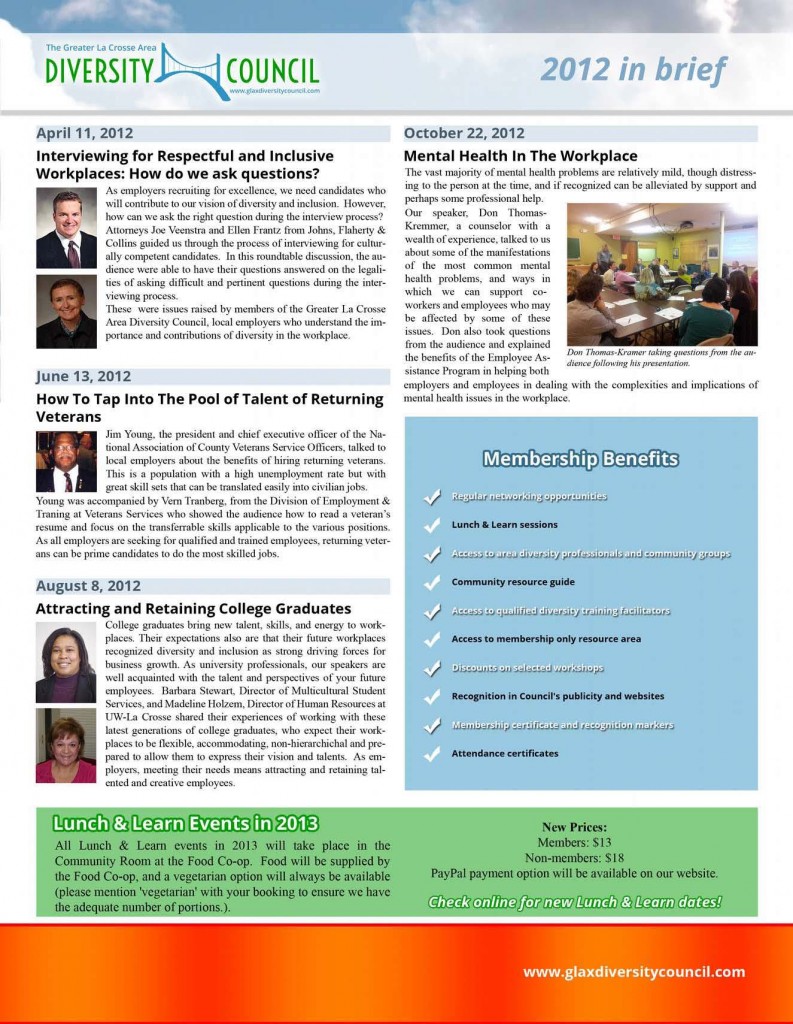
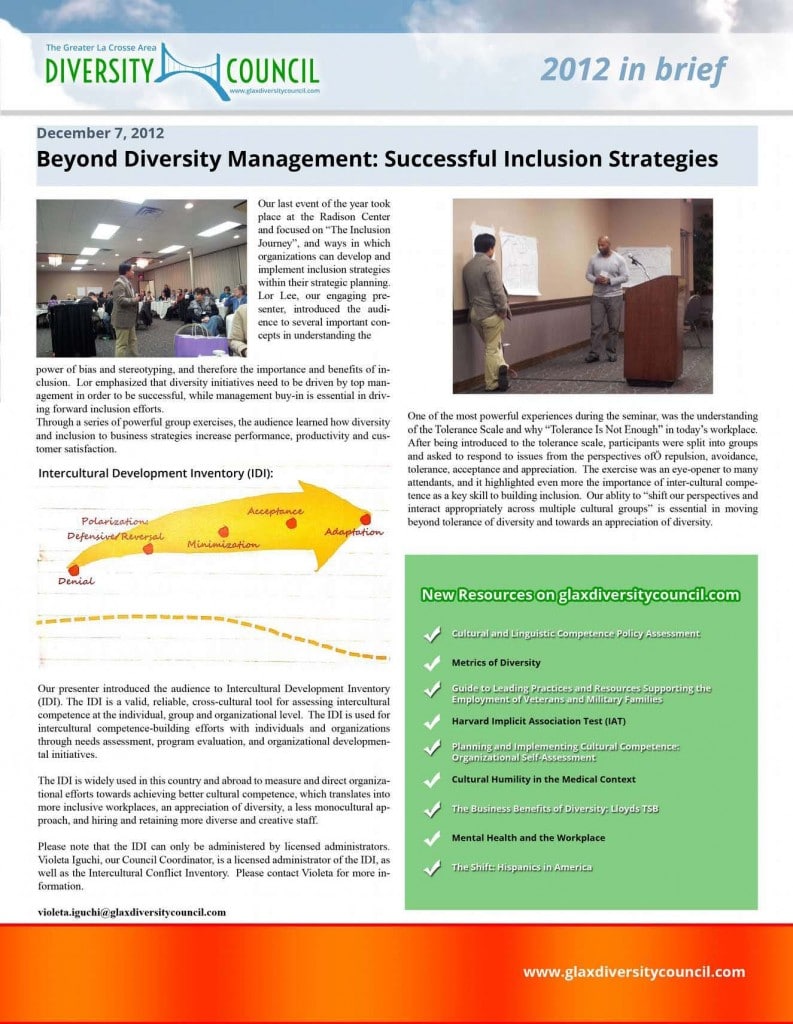
Our December event was a great success! We would like to thank our audience for their spirited participation, willingness to share, take risks and make the experience worthwhile!
We would also like to thank our presenter, Lor Lee, for his guidance through a wonderful process of leaving diversity tolerance behind, and the discovery of an appreciation for cultural diversity.
Based on your feedback and suggestions, the Diversity Council will endeavor to organize more trainings on issues related to cultural competence.
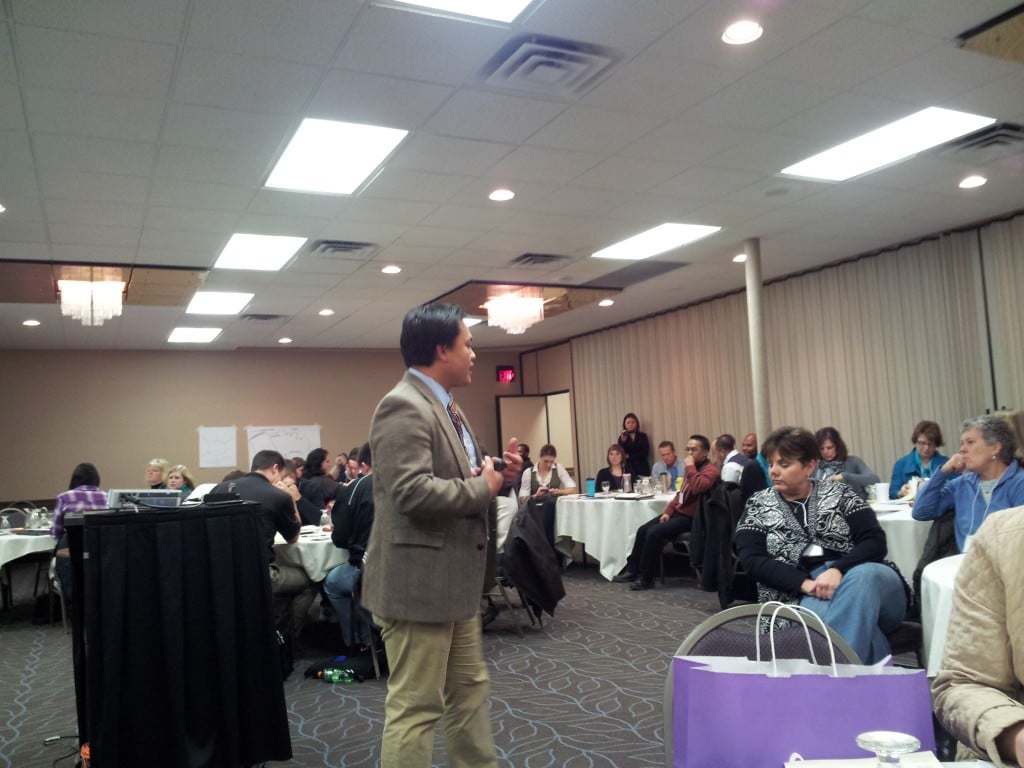
Keeping the audience engaged.
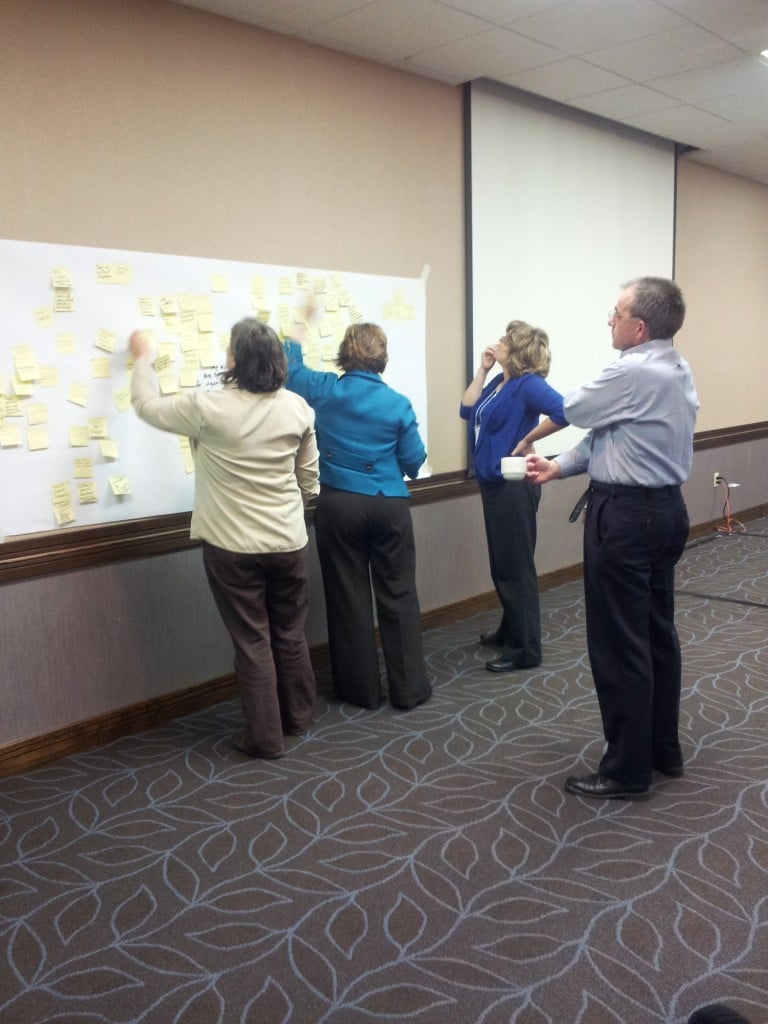
group exercise
-
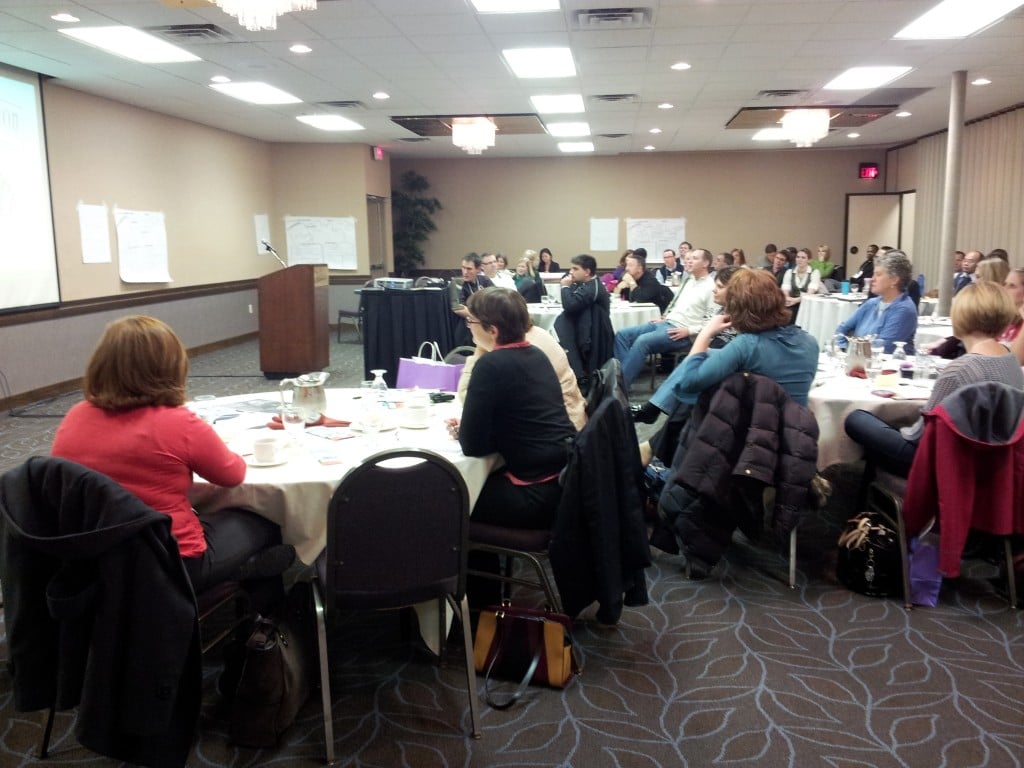

Beyond Diversity Management: Successful Inclusion Strategies
Radisson Center, December 7th, 2012
1. Instructor Rating for Lor Lee 4.79 (out of 5) 2. Environment and Support 4.45 (out of 5) 3. Learning Objectives (As a result of this program, I can….) 4.22 (out of 5) 3. How did you hear about this program Mailing: 4%Email: 38%WoM: 29%Other: 29% 4. Are you a member of the Diversity Council? Yes: 30%No: 70% 5. Did this event represent good value for money? Yes: 96%No: 4% 6. How relevant was the topic of this event for your professional development with regards to diversity, inclusion and cultural competence? Relevant: 33%Somewhat Relevant: 25%Very relevant: 42% Comments: “The speaker, topic, and facilities were all top notch. Having lunch served in a separate room was excellent and being served made it much more quickly too. (…) “ “I would love to become a member of the diversity council (…)” “I appreciate this opportunity in our community. I am hopeful this council can continue to provide opportunities for staff development on related topics in the future.” “The presenter was EXCELLENT and a very good value for the cost of the training. He uses a variety of teaching strategies that engaged the audience and were very relevant to the topic.” “I would love to be part of a diversity council, however the distance is great. I plan to investigate local initiatives.” “I like the descriptions of tolerance and other words on the scale of inclusiveness. I will use this tool with my students.” Suggestions “Shorten the lunch to 45 minutes.” “Since we had so many educators from the same building at this workshop, I think it would have been more beneficial for us to work together instead of working in different groups (…)” “(…) two trainings per year would be great: fall and spring.” “It would have been most helpful at the end of the day for the many school district folks to work together for our plan, rather than creating a virtual plan.” Topic suggestions “More knowledge regarding specific cultures and traditions.” “(…) a longer day around micro-aggressions would be powerful.” “a continuum of training related to developing cultural competence within any organization.” “We need more cultural training.” “Concrete differences between cultures (general). Schools are seeing a lot of African American boys entering the EBD program in elementary school. Perhaps a greater understanding of their culture would change the view that educators have on what behaviors are acceptable in their homes.” “Scenario based conflict negotiation when cultural diversity is influencing (…).” Copyright © 2025 The Greater La Crosse Area Diversity Council. All Rights Reserved.

